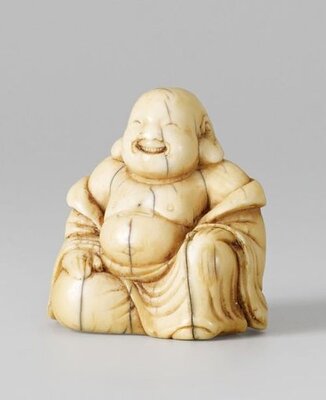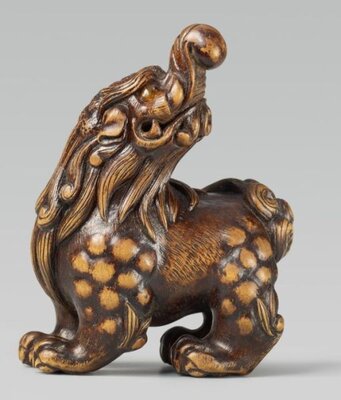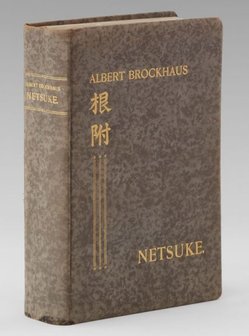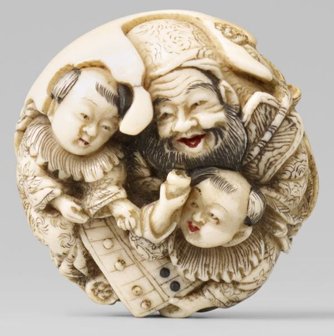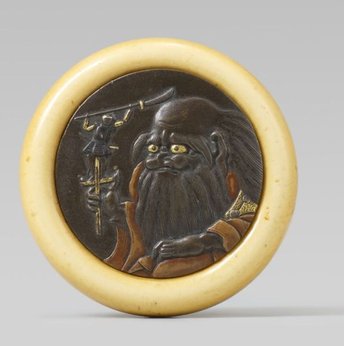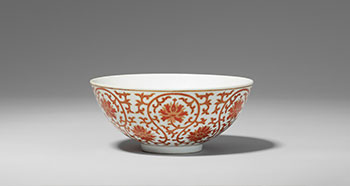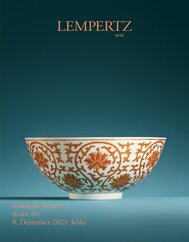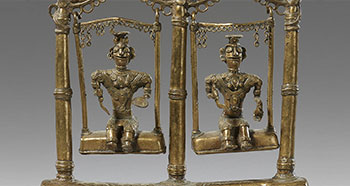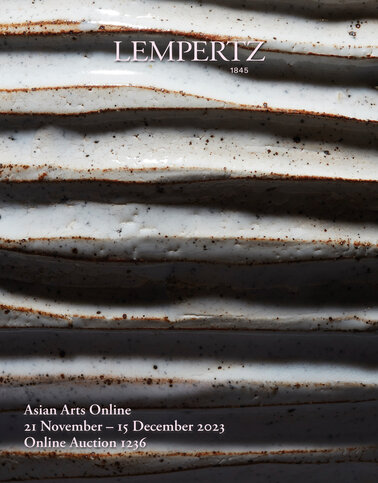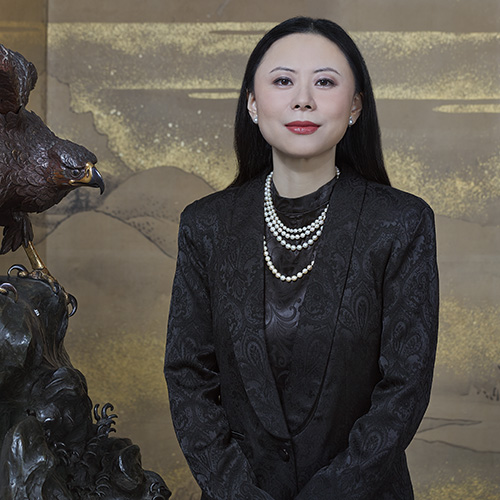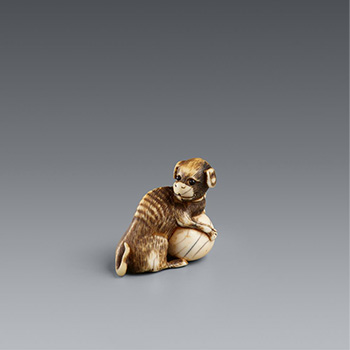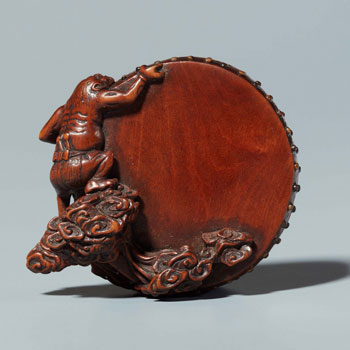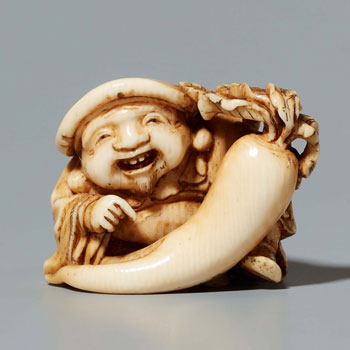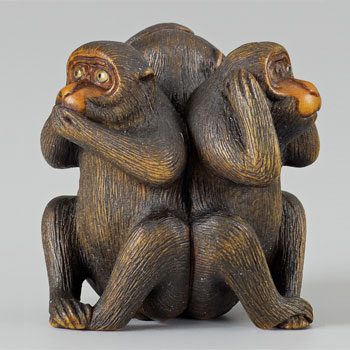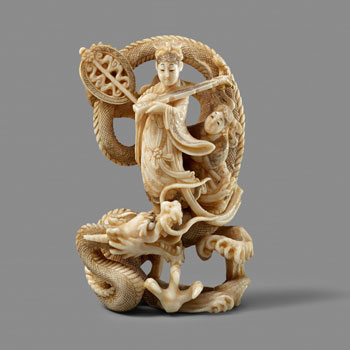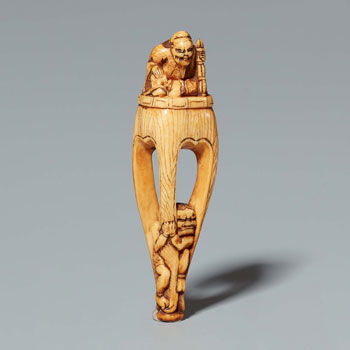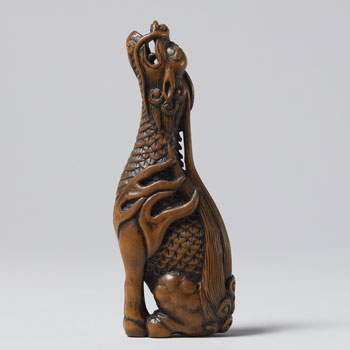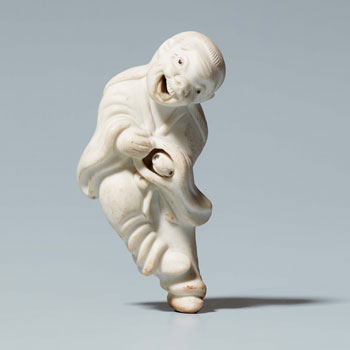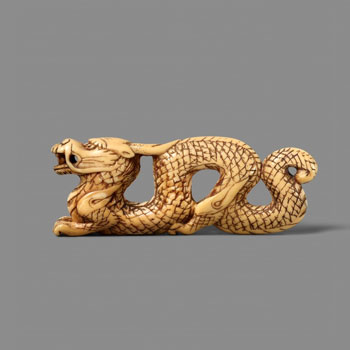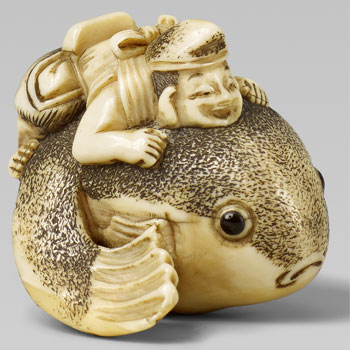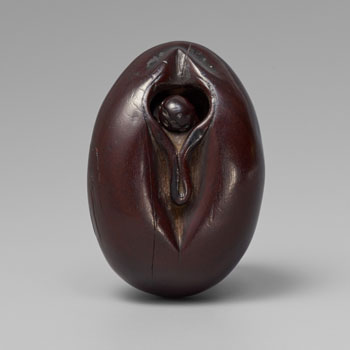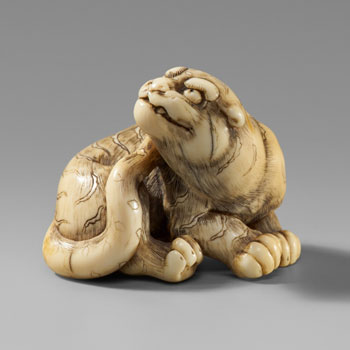Netsuke
Netsuke - It is one advantage of art to be able to reach the emotions of the viewer purely through the visual. Thus the question of a rational comprehensible use is often overlooked. However, Japan of the 17th century bore an art out of pure utilitarianism which still today awakens pleasure in collectors worldwide not only through the visual experience but also through its haptics – the netsuke.
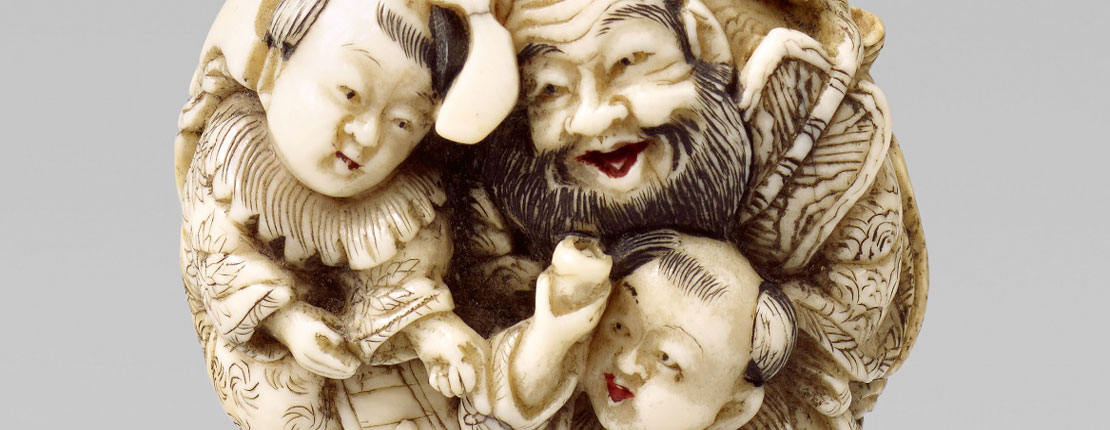
Netsuke - From the belt to the collection
Table of contents
- A found object becomes an art object
- Netsuke types and materials
- Hunting, purchasing and collecting - an introduction to collecting netsuke
- Auction - Asian Art, Netsuke
- Online Catalogues
- Contact
- Even more on the subject of netsuke
Netsuke - a found object becomes an art object
Traditional Japanese costume did not have any pockets, so everyday objects of the 17th century such as seals, ink pads or also medication were kept in small stacked containers (so-called inrô) (fig. 1). Leather pouches (dôran) or money purses (kinchaku) also needed to be carried. These objects (collectively known as sagemono; jap. = hanging things) needed then be fixed to a belt (obi) with a toggle. According to the translation of the Japanese word (ne = root, tsuke = hang), it is assumed that simple found objects such as misshapen pieces of root wood were used. However it is also likely that bones or other found objects could have played a useful role. Two connected holes (himotoshi) enabled a cord to pass through the object onto which all the necessary items could be hung. (Fig. 2). Starting originally with these found objects, the toggle over time became increasingly artistically worked.
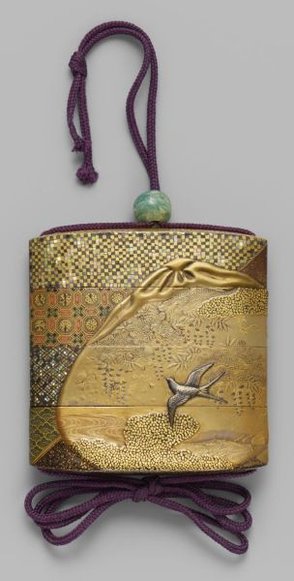
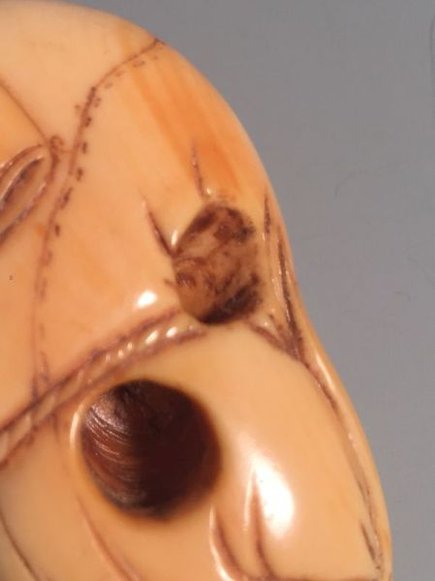
Netsuke types and materials
A strict categorisation of netsuke into various types is difficult. In general, the term katabori netsuke is a valid description of all three-dimensionally worked sculptures. From the 17th century (fig. 3) to contemporary carvings today (fig. 4), the almost inexhaustible wealth of motifs reflect the temporal world of Japan in nature and society, but also all that is transcendental and fantastical. The collection of the publisher Albert Brockhaus (1855 - 1921) offers an aperçu of all of these motifs. In his publication 'Versuch einer Geschichte der japanischen Schnitzkunst' (An attempt at a history of Japanese carved art) (fig. 5), the Leipzig collector not only published one of the most famous and renowned netsuke collections in the world.
For the sake of completeness, the anabori and ittobori types should be mentioned here. Both are however to be understood as less of a type, but more as the terminus technicus of their art of finishing. A further netsuke type is that of the manju (fig. 6) and kagamibuta (fig. 7). Both are of rounded, flat form , the name manju originating from the Japanese rice cake of the same name. Turned and carved, this type offers a clearly delineated, and at the same time a wide-ranging collecting field of motifs. With the kagamibuta, it is once again clear where the pragmatism of the development of this type lies.
Tobacco imported by the Portuguese into Japan in the 17th century grew quickly in popularity, and necessitated the carrying of smoking utensils by fashionable Japanese men. The tobacco container (fig. 8) (tonkotsu) and the matching pipe (fig.9) and pipe holder (fig. 10) (kiseru und kiseruzutsu) required a somewhat more resilient securement on the belt. The utensils are connected through the dish with a circular metal disc. This uppermost metal disc would naturally be decorated, such as with engravings or elaborate inlays. Once again it can clearly be seen how much utilitarianism and its artistic interpretation were interwoven in Japan, be it in the motifs or the choice of materials.
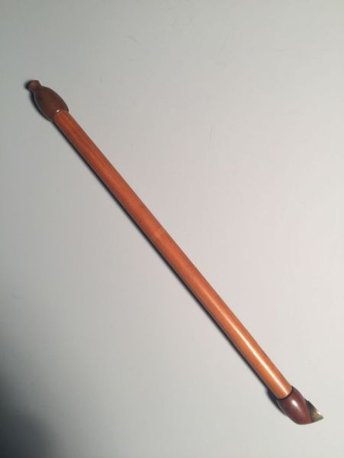

Alongside the metal kagamibuta-type are the katabori netsuke, primarily of ivory, stag antler, wood and coral. However these details are only to be understood in general terms, under which countless varieties are found. The aspect of the material is important for an all-encompassing art-historical classification and evaluation of a netsuke. How closely the material characteristics and working were associated is seen in netsuke from the Kyôto region of the 18th century. Due to the costliness of the elephant tusk (zôge), which was imported by the Dutch from the 17th century onwards, each carver had to handle his resources sparingly. The characteristic basic shape of the pieces is due to the fact that the tusks were initially divided - in the Teramachi quarter in Kyôto, for example, whole workshops were dedicated to cutting elephant tusks - and then the smallest possible triangular segment cut from the upper end of the tusk was used for carving (fig. 11). Later 19th century works with elaborate inlays testify to their increasing popularity, but also to the material knowledge of the netsukeshi (jap. = netsuke carver) (fig. 12).
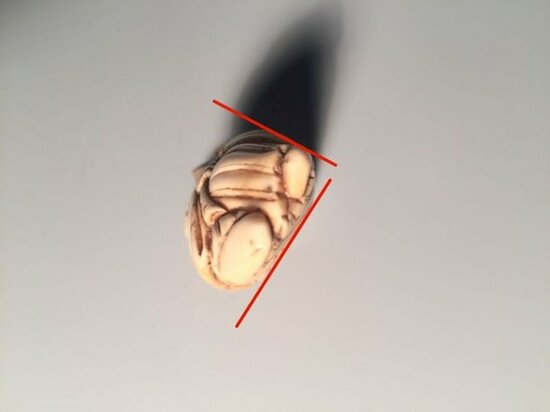
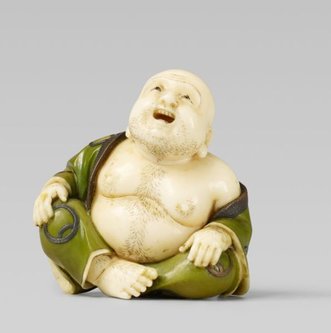
Hunting, purchasing and collecting - an introduction to collecting netsuke
When asked how many netsuke one needs to denote the group as a collection, the famous collector Ted Wrangham (1928 - 2009) answered: ''Three. Two to keep, one to exchange''. Everyone is free to raise their possessions to the level of a collection. For some collectors it is only necessary to have a collection concept. For example, the collecting of all the zodiac animals, or the depiction of a god of good fortune from all epochs and schools. In many collections, however, the heart seems to possess the greatest curative power. In the last few years there has been an increase in the number of purchases made on grounds of signatures. Works by Masano, Tomotada, Ikkan or Kokusai are guaranties of high results and long-lasting value. In view of the large number of unsigned netsuke, an attribution is often difficult. However, this is the breeding ground for beginners to gain expertise through dialogue with other collectors. Netsuke auctions with an international audience are sounded-out weeks before on forums such as the International Netsuke Society, and analysed object for object. Discussions on a carver's surface handling of a walrus tooth netsuke from the 18th century are spread across several pages. So where do you start as a collector? And what is there to offer as a beginner? In general, the following advice can be given:
- Handling is better than looking
- Critical analysis of style is more popular among connoisseurs than the unfounded belief in a signature. If this argumentation is not yet possible, refer to point 3
- Every netsuke purchase should be preceded by the purchase of three reference books
- 'Go for what you love'' - buy what you like (really, even if you are alone in this choice)
Everyone, regardless of the level of expertise, is recommended to have held in their hands the greatest possible number of netsuke in their collecting life. Collections such as in the Musée de Cinquantenaire in Brussels, the British Museum and the Victoria and Albert Museum in London, the Ethnographic Museum in Leiden, the Linden Museum in Stuttgart and the Museum of East Asian Art in Cologne all contain collections of some impressive pieces. The possibility of physical contact with the objects is not always possible, but always worth trying. The annual Netsuke Convention also offers the chance of contact with internationally traded pieces and their collectors. The program of lectures, workshops and auctions offers the chance to dive into the individual areas of this carving art. The simplest way however is to regularly visit the previews in specialist auction houses, such as Lempertz which offers a twice-yearly opportunity. A little physical assertiveness may be required at the display cases, but beware, as soon as the path is clear, eye and hand contact with the netsuke will quickly draw you into their orbit. Then, one hangs on to them like an inrô.
Netsuke-Auctions
Upcoming Auctions - Netsuke
Auction
November 21 – December 15
Lot 500 – 771
The Auction 1236 - AAsian Arts Online runs as an Online Only Auction from November 21 to December 15. During this time, you can bid on the auction lots via the internet.
Register now to participate in the auction!
Please note that a separate registration is required for our online auctions.
Please also note that due to the Money Laundering Act, we are obliged to carry out an identity check on our customers. You can easily and securely upload the necessary documents on our website.
You will find the link to this on the right.
Preview
Our passed Netsuke-Auctions
- Auction 1157 - Netsuke from the Albert Brockhaus Collection
- Auction 1136 - Netsuke, Inro and Sagemono
- Auction 1124 - The Papp Collection of Netsuke II
- Auction 1124 - Netsuke, Inro and Sagemono from a Rhenish Collection
- Auction 1112 - Contemporary Netsuke and Sagemono
- Auction 1112 - The Papp Collection of Netsuke
- Auction 1092 - Netsuke and Sagemono incl. The Kolodotschko Collection V
- Auction 1061 - The Kolodotschko Collection of Netsuke IV
- Auction 1053 - The Kolodotschko Collection of Netsuke III
- Auction 1044 - The Kolodotschko Collection of Netsuke II
- Auction 1036 - The Kolodotschko Collection of Netsuke I
Netsuke Prices
A few examples of netsuke prices auctioned in Lempertz auctions:
| Netsuke | Auction - Lot Nr. | Object | Price |
|---|---|---|---|
| Netsuke | Auction 865 - Lot 852 | Dutchman with hunted hare. Ivory and coral. Kyoto. 18th c. | 126.000 € |
| Netsuke | Auction 1157 - Lot 536 | A Kyoto school ivory netsuke of a horse, by Mitsuharu. Mid-18th century | 80.000 € |
| Netsuke | Auction 1157 - Lot 532 | A boxwood netsuke of a leaping hare. 19th century | 62.000 € |
| Netsuke | Auction 1190 - Lot 360 | A large ivory netsuke of a seated tiger. Ca. 1780 | 30.000 € |
| Netsuke | Auction 1036 - Lot 243 | A very unusual stag antler netsuke of an amaryû. Second half 19th century | 29.280 € |
| Netsuke | Auction 1006 - Lot 916 | Two fish. Ivory. Kyoto. Late 18th century. | 27.000 € |
| Netsuke | Auction 1157 - Lot 533 | A marine ivory netsuke of two hares jumping over waves. 18th century | 26.000 € |
Contact Persons
Netsuke - Consign Now!
Netsuke figures gallery
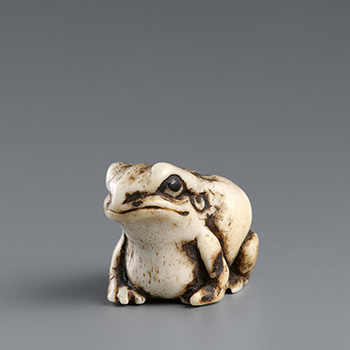
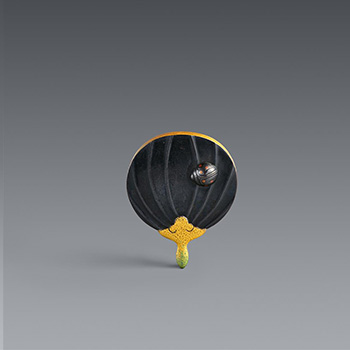
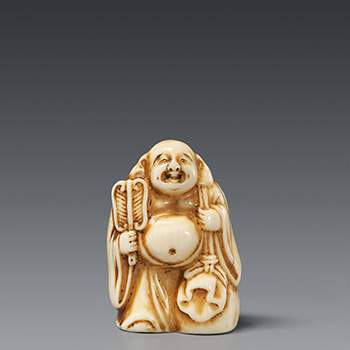
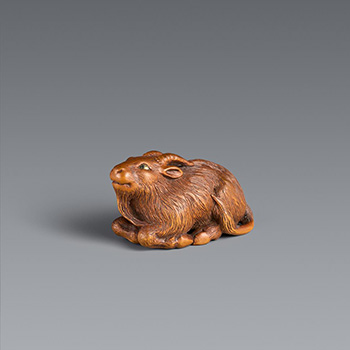
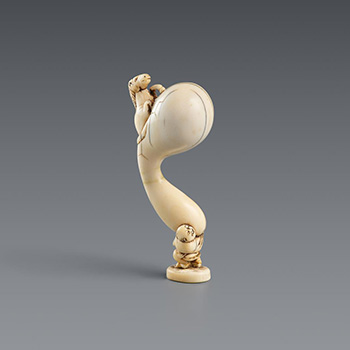
Even more on the subject of netsuke
- Ritsuo-Netsuke
- Teddy's Snails

